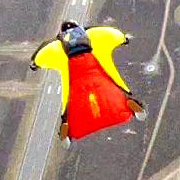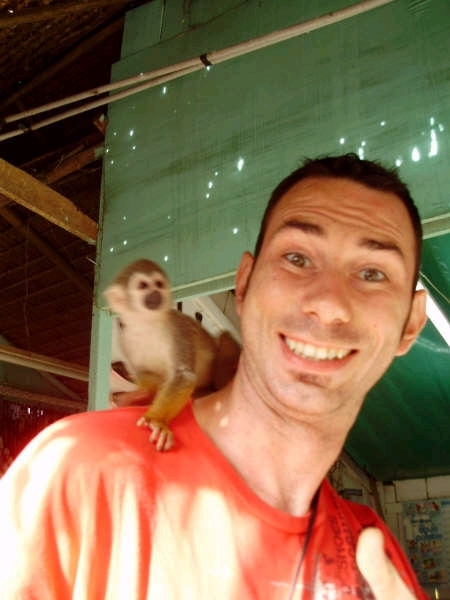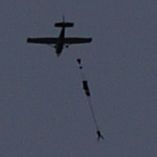STUDENT TRAINING USING Two ACTION WITH RSL on the cutaway And AAD on reserve
By
stevepearce, in Safety and Training
Recommended Posts
AFFI 0
QuoteIf an E-licence jumper can STILL do this, despite all the training, why do we expect a student (from first or second jump) to do better?
What does an “E License” entail exactly?
Your comment “despite all the training” implies to me that this license level must illustrate a level of proficiency in dealing with EP’s on a regular basis throughout the year (?).
In the US, we have the “D License” which does not require any training review throughout the year what so ever, in fact, none of the license levels for current license holders require such a review.
My observations are that “experienced” jumpers seem to make training for emergency procedures and canopy piloting (especially when the chips are down) secondary to freefall skills, apparel and in general being hip slick and cool. I see and read about “experienced” jumpers making terrible mistakes based in fundamentals all the time.
A student who is properly trained is much more prepared to correctly handle a situation than many licensed skydivers out there simply because so many “licensed” skydivers do not continually train in the fundamentals.
This dissertation by Peter is definitely worth reading multiple times, overall a very good post.
Skydiving Priorities: 1) Open Canopy. 2) Land Safely. 3) Don’t hurt anyone. 4) Repeat…
Your input is making me a better FJC teacher AND a better skydiver.
Thanks again guys…there’s at least one of us out here listening.
I think we're all Bozos on this bus.
Falcon5232, SCS8170, SCSA353, POPS9398, DS239
gravity7 0
re: E-license. In Australia sporting licences are issued up to F (500 jumps for E, 1000 for F). I should probably have said "all the experience" not "all the training".
The main purpose of E and F is as a pre-req for various ratings (including proven accuracy), rather than detailing all those standards for each rating or endorsement. Thus, a Tandem Master candidate would normally be expected to already hold an E license.
I also left out one of the primary design features of the SOS - it is IMPOSSIBLE in normal use to do an out-of-sequence EP. With normal two-action, it is possible to pull the reserve before (or without) cutting away. SOS or DOS prevents this. It also eliminates the need to decide whether or not to chop before pulling reserve.
Remember that SOS/DOS were designed to save STUDENTS! Once these people have more experience, and less sensory overload, normal TAS is fine.
(seize the throat)
As a case in point, the recent Byron Bay fatality shows that experienced
jumpers (500+ jumps) can still cutaway, and not pull their reserve (no RSL,
no AAD). If an E-licence jumper can STILL do this, despite all the
training, why do we expect a student (from first or second jump) to do
better?
in reply
i think peter b missed a simple point the concept included an RSL ?
and as for overlearning and transitional changes from gear types to current trends some very competant jumpers died making those changes from gear types due to primacy in learning
just because pete was able to vary without a problem isnt the absolute norm
cheers steve
Risk factors do not add up, they multiply
QuoteIf an E-licence jumper can STILL do this, despite all the
training, why do we expect a student (from first or second jump) to do
better?
Do you have the your E-licence jumpers in the training harness in every 3 month? Because we have our students there and practicing emergency procedures hundreds of times..... thats way we expect to save their lives and they have RSL installed too. Muscle memory and emergency training works.
Risk factors do not add up, they multiply
sundevil777 102
I would think that later retraining would be easier if the SOS handle was on the right, so that the students instinct to go to the cutaway first instead of the reserve handle side is still there.
BIGUN 1,399
QuoteSince licensed jumpers do not use ground-to-air radio, should student radios be eliminated?
Yes.
AFFI 0
QuoteQuoteSince licensed jumpers do not use ground-to-air radio, should student radios be eliminated?
Yes.
Absolutely not.
Radios should be used with students, but there should be more emphasis on proper utilization as a training tool. Learning to appropriately use the radio as a training tool was of the more difficult aspects of quality instruction for me to learn.
I once heard the DZO where I jump say “correctly using the radio is the hardest thing for an instructor to master” and I would have to say I agree with him.
Skydiving Priorities: 1) Open Canopy. 2) Land Safely. 3) Don’t hurt anyone. 4) Repeat…
lippy 918
QuoteI would think that later retraining would be easier if the SOS handle was on the right, so that the students instinct to go to the cutaway first instead of the reserve handle side is still there.
I'd think it more important that their first instinct is to get nylon over their head. But that's just more fuel for the debate of how stupid can the students really be...
lippy 918
QuoteYes, Beiseker, Alberta may have used double-action Javelins for many years, and yes, I repacked all those Javelins for their last year of service, but I still thought they were a rigger's nightmare
I remember once when I was working as a packer there for Jim I was disconnecting a main from a student Jav that was going in for repack to attach it to another. I disconnected the RSL and I cut away, then went to separate the risers from the ring. The NON-RSL side didn't separate because the reserve ripcord cable was through the double loop twice and the cutaway cable didn't go through at all.
I'd like to think that it would be caught before anybody got on a plane, but that could of turned out nasty.
'Too many moving parts'...Well said Rob
BIGUN 1,399
QuoteAbsolutely not. Radios should be used with students, but there should be more emphasis on proper utilization as a training tool. Learning to appropriately use the radio as a training tool was of the more difficult aspects of quality instruction for me to learn. I once heard the DZO where I jump say “correctly using the radio is the hardest thing for an instructor to master” and I would have to say I agree with him.
We're going to have to disagree on this one, Mykel. A few years ago to prove my point, we split a class in half. I taught one without radios, the other Instructor taught one with... The students who did not have radios landed EXACTLY in the center of the DZ. The one's who were taught with radios didn't fare as well.
You wanna know why the radio is the hardest thing to master? Because it's not the radio... It's the Instructor knowing they relied too heavily on the radio and taught for the radio, not for the landing pattern, crabbing, landing downwind of the DZ, etc. In fact, you want to see an Instructor panic? Walk up to him while he's on the radio, take it away, turn it off and say, "Now what?"
Ever since DZ's found ways to shorten the period of time and cram 'em thru a 4 hour course... now don't get me wrong... Instructors want to be professionals, but DZ's need to generate revenue and so they press the Instructors to churn 'em and burn 'em and since the DZs pay the Instructors....
Let me ask you this... How long would the FJC be if we didn't have Radios, AADs, or RSL's? We should be teaching to that standard. Everyone keeps talking about the number of skydivers diminishing. It's simple math, we're not loading the front end as the back end drops off. We're teaching people to jump from a plane, call it a skydive and they walk away feeling "lucky," rather than confident. Plain & simple, we're not teaching them confidence in their abilities to come back.
Just one man's opinion.
AFFI 0
QuoteA few years ago to prove my point, we split a class in half. I taught one without radios, the other Instructor taught one with... The students who did not have radios landed EXACTLY in the center of the DZ. The one's who were taught with radios didn't fare as well.
Let’s keep in mind that we are not comparing Apples to Apples. The individuals you had in your half may have had a more natural capability to think in 3 dimensional space and the other instructors training methods may have been inferior to yours or not communicating to the varying personalities in the other half effectively. Lastly, the other instructor may have not been using the radio in an appropriate manner.
There are too many variables to make a determination like this on the outcome of one insufficiently conducted test. Just to try and "prove your point" you placed first jump students at a potentially greater risk of injury.
Putting students out without radio is a disservice to the students safety and is a liability hazard. What if a student flew into an obstacle and suffered injury or death, the fact that they did not have radio guidance could be considered gross negligence as we are in an industry where radio use is standard for first jump students.
An instructor putting a solo freefall student out without a radio, especially a low level student would not be tolerated where I work. This test is inexcusable to the philosophies that I have been taught to utilize as guidelines for training first jump students safely. Glad everything turned out ok...
QuoteIt's the Instructor knowing they relied too heavily on the radio and taught for the radio, not for the landing pattern, crabbing, landing downwind of the DZ, etc.
Then we actually agree, we are both talking about “properly” using the radio as a training tool.
Skydiving Priorities: 1) Open Canopy. 2) Land Safely. 3) Don’t hurt anyone. 4) Repeat…
BIGUN 1,399
QuoteThe individuals you had in your half may have had a more natural capability to think in 3 dimensional space and the other instructors training methods may have been inferior to yours or not communicating to the varying personalities in the other half effectively. Lastly, the other instructor may have not been using the radio in an appropriate manner.
Therein lies the problem. Everyone has the ability to learn the 3 dimensional aspects of space, but use of the radio gives the Instructor permission not to spend the time teaching it.
QuoteThere are too many variables to make a determination like this on the outcome of one insufficiently conducted test. Just to try and "prove your point" you placed first jump students at a potentially greater risk of injury.
DIsagree. Give the students more knowledge and therefore reduce their potential for risk of injury.
QuotePutting students out without radio is a disservice to the students safety and is a liability hazard. What if a student flew into an obstacle and suffered injury or death, the fact that they did not have radio guidance could be considered gross negligence as we are in an industry where radio use is standard for first jump students.
I would contend that not training the students to handle the situation without a radio could be considered gross negligence. Using your argument, would an Instructor be grossly negligent if a radio failed for any reason and the student were seriously injured or killed? Why not? Where was the backup radio? We have a backup parachute; why not a backup radio if it's that important?
QuoteAn instructor putting a solo freefall student out without a radio, especially a low level student would not be tolerated where I work. This test is inexcusable to the philosophies that I have been taught to utilize as guidelines for training first jump students safely.
I learned some good philsophies where you work for one of my ratings and have nothing but respect for the staff there. However, you've learned "a" philosophy for training students safely. I'd like the opportunity to show you another philosophy. You and I share a lot of passion for training and agree on a lot of points. Some from your showing me your training methodologies and some from the written word. I would ask that before you totally refute my point, you give me the opportunity to have you sit in on a non-radio FJC and watch the students perform under canopy.
I have been teaching canopy control without mentioning the radio for 12 years.
hackish 8
Having read this thread and understanding a little more how the SOS works I'm not that confident that my pulling the SOS would have resulted in a complete separation/reserve pop.
Part of the instruction needs to explain the fine operational details. Probably the instructor had never pulled or seen an SOS used or he would have explained how important it is to pull the single handle all the way.
-Michael
this in itself is not common practice and acually
is a breach of safety regulations
so i must say being confused and scared about two action and or SOS would be the norm
lets hope your course of instruction doesnt end up in a fatality
blueskies steve
Risk factors do not add up, they multiply
billvon 3,063
This happens sometimes. I made my first 15 jumps on an SOS/throwout then switched to a TAS/ripcord (went from SL at one DZ to AFF at another.) Good retraining is critical in such cases, but if it's done well, it's not prohibitively dangerous.
hackish 8
Quotei find your comments rather disturbing with 2 posted jumps and you have been so you say trainned on two types of gear
this in itself is not common practice and acually
is a breach of safety regulations
so i must say being confused and scared about two action and or SOS would be the norm
lets hope your course of instruction doesnt end up in a fatality
The first jump was at the Atlantic School of Skydiving in Waterville NS. I did it while on vacation with my significant other. We went out for a full day of training (she did a tandem). They spent a significant amount of time teaching proper exit procedures and flight checks/when to whip it out. They just didn't seem to cover the mechanics of using the SOS that well. "Here pull this thing" instead of "You need to pull this handle hard and make sure you pull it a long way out or bad things might happen". Practise could have been an asset too.
My first jump (IAD at 3500) got my hooked so I found the local DZ when I returned home to Quebec. The instructor went through and tested me on all the details they teach. He was very satisfied with what I knew. I had also spent some independent time educating myself with a book and reading online articles. I was not familiar with the TAS on their gear so he spent about 1/2h explaining, showing and then a number of test breakaways on a practice rig.
I don't know if and why my experience should be considered "disturbing" but from an absolute beginner's prospective I did want to give my feelings on being exposed to the 2 systems.
Don't characterise "less confident" as being scared and/or unable to use the system. From a beginner's prospective pulling 1 handle seems simpler but the importance of a proper pull must be stressed.
-Michael
riggerrob 643
The first jump was at the Atlantic School of Skydiving in Waterville NS. ... They just didn't seem to cover the mechanics of using the SOS that well. "Here pull this thing"
...
Sounds like they did not learn a blessed thing from the 1970s fatality in Australia or a near-fatality in Waterville in 1984.
Hint: I was the jump-master in 1984.
The only reason the 1984 incident did not result in a fatality was Saint Francis Xavier Chevrier being on duty.
In conclusion - when jumping SOS - students should be taught to pull hard and pull long and continue pulling until they have three cable ends flopping loose, then throw the handle away!
thank you for expanding your jump history but if you re read your initial post you might see how my comment is justified
stay safe cheers steve
Risk factors do not add up, they multiply
hackish 8
I was trained on both systems although when doing independent research did find that my SOS training did miss a small but very important point.
My main reason for bringing this up is that those designing the instruction need to make sure that important details are not overlooked.
-Michael







.thumb.jpg.4bb795e2eaf21b8b300039a5e1ec7f92.jpg)
I am posting this on behalf of a friend who is not too computer literate.
He has sent an email to the OP but his thoughts are well stated so would be good value added to the debate.
...it lets me down.
Share this post
Link to post
Share on other sites